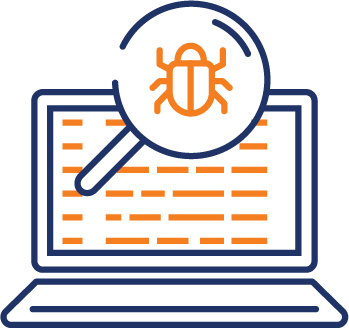Cybersecurity

Cybersecurity Solutions
Cybersecurity is an often-overlooked aspect across businesses worldwide. While some have a weak security posture, others might grapple with time, costs, and resource factors for a proper cybersecurity implementation. The recent surge in malicious attacks by hackers uses advanced technologies that detect deep-rooted vulnerabilities to breach the business network and access confidential transactional and operational data.
What lies at stake is the threat of disruption in business operations and misuse of your customer and payment data, which have deep-set implications for your business’s reputation.
Understanding Cybersecurity Threats and Risks
Cybersecurity stands as a paramount concern for businesses regardless of their size. It’s imperative for business owners and IT professionals to grasp the ever-evolving threats and risks present in the online realm.
Specific verticals need a higher security posture due to the type of data they deal with. If you are running a healthcare facility, you must have a robust security posture to protect you from cyberattacks. What lies at stake is sensitive customer data and medical records, and a breach will have profound ramifications.
Understanding these threats is crucial for safeguarding sensitive data against cybercriminals who continuously adapt their tactics. Common cyber threats such as DDoS, phishing attacks, ransomware, malware infections, and ransomware are among the critical focal points.
Moreover, it is vital to recognize the potential ramifications of a successful cyber-attack, including financial losses, damage to reputation, and legal ramifications. Such a possibility necessitates using an expert in-house team or a Managed Cybersecurity Service.
Practical tips and strategies are essential to mitigate these risks.
These include enforcing solid passwords, ensuring regular software updates, and providing comprehensive employee training on cybersecurity protocols. By implementing such measures, businesses can bolster their defenses against cyber threats and uphold the security of their valuable assets.
The Different Types of Cybercrimes
Cybercrimes also use artificial intelligence to maliciously compromise your network and data. Whether you run a small business, a large enterprise, or even a global conglomerate doesn’t matter. Businesses of all sizes, geographic expanses, and diversity in operations all face the same threat from cybercrimes.
As a business owner, you need to know what matters the most in improving your cybersecurity posture and understand the benefits of Managed Cybersecurity Services. It would help if you started with cybersecurity consulting for businesses, which gives a complete understanding of ways to enhance your cybersecurity posture.

Let’s look at some of the most common cybercrimes related to business enterprises.

Malware
Malware attacks inject malicious software such as Trojans, viruses, or spyware on a target system or network intended to cause loss or misuse of data and the network.

DDoS
Destructive Denial of Service is a malicious website attack that constantly generates false traffic. A website under a DDoS attack makes it nearly impossible for genuine customers or clients to access the site, with the eventuality that the site crashes and the network is overwhelmed with false traffic.

Cyber Espionage
Cyber Espionage refers to malicious attempts to access sensitive data and intellectual properties to gain a competitive advantage.

Phishing
Phishing is a cybercrime in which deceptive emails and links impersonate your business domain to gain access to sensitive customer data. It erodes customers’ trust in your brand by cleverly impersonating your business email address and making the link look similar to the one your domain uses.

Ransomware
In recent times, there has been a massive surge in ransomware, where malicious hackers exploit vulnerabilities in your network security and gain malicious access to data and sensitive information. Such data is often sold in grey markets if you do not pay the required ransom to regain control over your systems and network.

Data Breaches
Data Breaches are malicious hacking attempts to steal business, customer, and payment information. They have deep-set implications for your brand reputation and the security of payment information. Such attempts will erode customers’ trust in your business and cause a loss of reputation and customers. It would help if you began enhancing your security posture with cybersecurity consulting for companies to determine the best way to safeguard your sensitive data.
The above are just a few prominent hacking attempts in a broad generality. As a business owner, you must have an efficient security posture and keep innovating your security systems to avoid malicious attacks. Cybersecurity either involves having a dedicated in-house team, which requires high upfront costs and resources, or you have the option to outsource your requirements to a managed cybersecurity service provider.
Investing in cybersecurity services is no longer an option but an imperative that you need to implement to secure your business. The journey starts with dedicated cybersecurity consulting specific to your current security posture and ways to improve it.
Preparing Your Business Against Cyber Attacks
Preparation is paramount in the realm of cybersecurity. A comprehensive guide for business owners and IT professionals is available to aid in fortifying businesses against cyber threats.
Recommendations and practical tips include regular software and security patch updates, educating employees about phishing and social engineering tactics, and establishing stringent access controls to safeguard sensitive data. Such services require expert cybersecurity consulting that offers a comprehensive analysis and custom solutions.
This guide underscores the significance of crafting a cybersecurity strategy tailored to the business’s specific needs and objectives. It outlines vital components of a robust cybersecurity plan, including risk assessment, employee training, network security, data backup, and incident response planning.
By adhering to these measures, businesses can significantly decrease their susceptibility to cyber-attacks and mitigate potential operational disruptions. If you are in a lean staffing mode or require expert assistance, a Managed Cybersecurity Service is highly recommended.
Let’s examine the top ten tactics that will help you build a good security posture for pre-emptive management and in case of security incidents requiring immediate remediation. The idea is to be equipped and informed.
Top Ten Steps to Strengthen Your Cybersecurity
Risk Assessment
A Risk Assessment is the fundamental step in implementing a Cybersecurity practice in your organization. You need to evaluate your network, devices, and BYOD (Bring your Own Device) equipment with a comprehensive audit that gives complete insights into your vulnerable areas that require immediate attention. A thorough risk assessment will help you discover gaps in your security and understand the risk you have. The evaluation also requires a security roadmap for future technology upgrades.
Regular Security Updates
While having a good security posture gives you the much-needed protection against malicious attacks, you also need to consider having regular updates that equip your Cybersecurity measures with the required capabilities to mitigate threats detected elsewhere. Frequent updates are equally important for your software applications, as they have a high degree of vulnerability that modern hackers exploit to gain control.
As much as modern technologies such as Artificial Intelligence (AI) and Machine Learning (ML) give you predictive insights into areas of concern, hackers use such technologies to find undetected vulnerabilities in your system. Explore managed cybersecurity services that use the best technological advancements to secure your business.
Implementing Multi-factor Authentication (MFA)
Regular passwords no longer work today, as you need an added layer of security to ensure the right person is accessing the network. MFA offers two-tier access credentials that enable secure authentication.
Regular Monitoring
Your cybersecurity experts need to monitor your data, network and devices 24/7. The cybersecurity team will need to schedule network traffic monitoring with active vulnerability logging and implement a remediation strategy if something happens. If you have a lean team already overwhelmed with different tasks, actively consider outsourcing your cybersecurity practice to a managed cybersecurity service provider such as New Era Technology.
Incident Response Plan
An essential part of a cybersecurity system is a proper Incident Response Plan. When you are pre-equipped with a mechanism for incident management, you benefit from easy restoration and an accelerated business-as-usual (BoA) timeline. An Incident Response plan is essential when you start your journey with cybersecurity consulting for businesses.
Employee Training
Employee training is essential to educate your cybersecurity team and regular employees on safely using devices and the network. Employees pose the greatest threat to your cybersecurity. Mandatory cybersecurity training will reduce the risk of an employee clicking on a malicious email or sharing sensitive company data. A managed cybersecurity service provider will also offer essential training to educate your employees and drive effective change management.
Regular Backups
Having regular data backups is imperative to remediate a malicious attack quickly. It ensures faster restoration of your data and applications. You must also have a cloud-based operating model and move away from conventional on-premise infrastructure. This gives you an added layer of security, as public clouds are always on top of a secure environment.
Invest in Modern Tools
Technological advancements have made implementing cybersecurity more efficient. You need to invest in modern Intrusion Detection solutions, Firewalls, and Endpoint Detection and Response (EDR) systems to enhance your cybersecurity capabilities. Before you make a change, consider having an initial cybersecurity consulting for businesses, which gives a holistic overview of what you need to implement.
Network Segmentation
You must segregate data, applications, and networks based on usage and priority patterns. Having multiple storage locations gives you the advantage of storing your critical data more securely and your regular data in an easily accessible place.
This gives you an advantage of enhanced security for crucial data, which mitigates most of the known security vulnerabilities, limits breaches, and facilitates restoration in cases of a cybersecurity incident.
Selection of a Cybersecurity Partner
You need to evaluate the diverse cybersecurity management services offered by many Managed Cybersecurity service providers. The choice needs to factor in the credibility, engagement model, required technical expertise, affiliations with major Cybersecurity solution providers, and the extent of the engagement. While costs matter, do not compromise where it matters the most.
New Era Technology offers a free Vulnerability Assessment to check your current security posture for five external IP addresses. The analysis includes a comprehensive assessment of your existing vulnerabilities and a discussion with our SecureBlu expert to review the findings and suggest a suitable remediation strategy.
Managing Incident Response and Dealing with Ransomware
In today’s cyber landscape, businesses must have a robust incident response plan. Understanding how to manage incident response and tackle ransomware is essential for safeguarding against cyber threats.
Businesses face specific challenges posed by ransomware attacks, a prevalent form of cyber extortion. Preventive measures like regular data backups, network segmentation, and user awareness training are vital to mitigate the risk of such attacks.
Understanding how to manage incident response and tackle ransomware is essential for safeguarding against cyber threats. A well-defined incident response plan that outlines the necessary steps in the event of a security incident is essential. This includes incident detection, containment, eradication, and recovery.
When responding to a ransomware incident, isolating infected systems, contacting law enforcement, and engaging with cybersecurity experts are essential. With proven best practices, businesses can minimize the impact of ransomware attacks and ensure a swift recovery.
>> Discover How Your Company Should Respond During an Incident
What are the Essential Security Solutions I Need?
Secure your business in today’s digital world to ensure longevity. Cyber threats, data breaches, and security risks can harm your business if you are unprepared. Implement essential security solutions to protect your network and systems and educate employees.
Explore these solutions:
Identity Solutions such as Azure Conditional Access
- Manage access to data based on specific fields and risks.
- Stop unauthorized access and prevent account takeovers.
Endpoint Detection and Response (EDR)
- Monitor and defend endpoints in real-time.
- Detect and prevent threats before they reach endpoints.
Managed Detection Response (MDR)
- Combines technology, threat intelligence, and human judgment.
- Provides 24/7 monitoring, detection, and response to threats.
Next-Generation Firewall (NGFW)
- Offers enhanced visibility into threats and network traffic.
- Strengthens security posture with advanced features.
Security Information and Event Management (SIEM)
- Collects and analyzes security logs from various sources.
- Improves incident detection and response capabilities.
Consider Emerging Cybersecurity Technologies

Zero Trust Architecture
Zero Trust Architecture is a robust process based on continuous monitoring of access privileges for both data and devices. The idea is to give access privileges strictly as per the requirements to prevent unauthorized insider access. In addition, Zero Trust Architecture creates a one-to-one secure connection, which secures both endpoints. It also prevents unauthorized external access to data, making it one of the highly preferred security implementations. Lean more about Zero Trust Architecture.

Artificial Intelligence (AI) and Machine Learning (ML)
AI and ML technologies enhance your existing security posture by analysing data and access logs and providing valuable insights that enable you to take both pre-emptive and current security remediation. Such technologies also provide futuristic insights based on current data so that you are aware of upcoming threats. While AI and ML are now integral to cybersecurity solutions, you must choose a security model that leverages their extensive capabilities.

Secure Access Service Edge (SASE)
Secure Access Service Edge is a cloud-based security offering that secures data, users, devices, and IoT without the need for a physical data center. This provides faster access, reduces latency, and provides configurable security according to the business’s regulatory norms.

Extended Detection and Response (XDR)
Extended Detection and Response (XDR) is an integrated security platform that uses Artificial Intelligence (AI) to monitor various security devices and derive insights. The insights are analysed to provide adequate response and remediation strategies, along with Predictive Intelligence features that enable pre-emptive risk mitigation.
>> Download the Cybersecurity E-Book to learn the latest trends
Implementing a Security Operations Center (SOC) or Managed Detection and Response (MDR)
As cyber threats evolve, businesses must take proactive steps to bolster their cybersecurity defenses. This exploration delves into the advantages of implementing a Security Operations Center (SOC) or Managed Detection and Response (MDR) services.
A SOC is a centralized unit tasked with monitoring, detecting, and responding to cybersecurity incidents. It underscores the benefits of having a dedicated team of security experts capable of swiftly identifying and addressing potential threats in real time. Conversely, MDR services offer a holistic cybersecurity approach by integrating advanced threat detection technologies with expert human analysis.
Investing in a SOC or MDR empowers businesses to elevate their cybersecurity capabilities and ensure prompt incident response. The discussion also delves into critical considerations when deciding between a SOC and MDR, including budget constraints, internal expertise, and industry-specific requirements. These insights guide business owners and IT professionals in making well-informed decisions to safeguard their organizations against cyber threats.
>> Read More on Whether Your Business Needs a SOC or MDR
Managed Cybersecurity Services from New Era Technology
New Era Technology has vast experience providing a wide range of Managed Cybersecurity services and solutions that suit every requirement. We offer all the above essential solutions plus advanced services which enrich your existing cybersecurity landscape.
Our SecureBlu portfolio is enabled by close to 25 years of experience, with a well-qualified team certified by leading cybersecurity solution providers.
What We Offer
Identify
- Security & Risk Assessments
- Tools Rationalization
- Threat Management
- Asset Management
Protect
- Third Party Risk Management
- Vulnerability Management
- Multi-cloud security integration
- SASE & DLP
- Security Posture Management (CSPM, SSPM)
Transform
- GenAI Security
- Zero Trust Architecture
- Identity & Access Management
- Firewall Modernization
Detect and Respond
- Managed Detection and Response (MDR)
- Incident Response
- Cyber Resiliency
- Penetration Testing
- SOAR
Advise
- Governance, Risk, and Compliance
- Security Program Maturation
- Merger & Acquisition
- AI Governance & Security
- Anti-fraud Architecture
- Data protection
What Makes New Era Different
Our SecureBlu Managed Cybersecurity services include our decades of experience providing comprehensive services attuned to your business needs. Our expert staff is certified in delivering various cybersecurity services to diverse needs. We offer a flexible service that enhances your security posture and makes your business resilient, robust, and secure.
For more information on our Managed Cybersecurity services, contact our experts and explore how we add value to your diverse needs.

 Canada
Canada Australia
Australia New Zealand
New Zealand UAE
UAE United Kingdom
United Kingdom